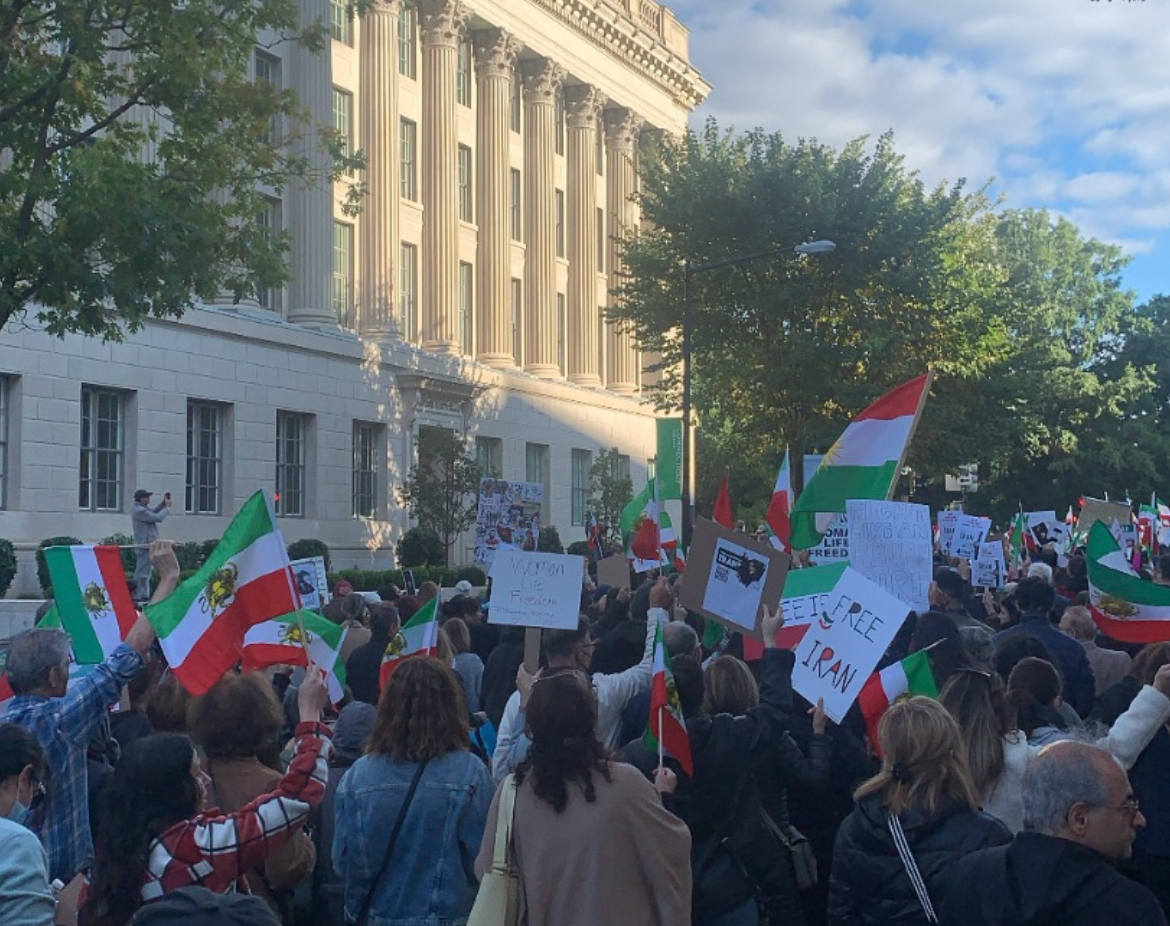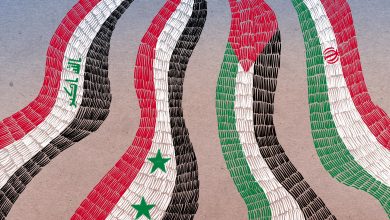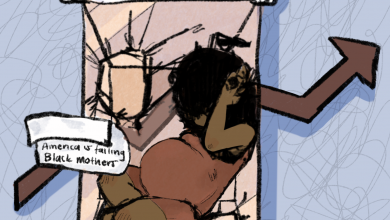Islam Could Not Disagree More With the Iranian Government; Standing With Iran’s Women

Protest in Washington DC in support of the Iranian women against the Iranian government’s violence against women.
Image Description: A large crowd of people waving Iranian flags and holding signs – one reading “free Iran” protest in DC against the Iranian government.
The Arabic language is read from right to left. So, when Muslims read the Qur’an in its original language, it tends to confuse the average person who most likely does not read Arabic. Adapting to the book – even understanding the intricacies of the religion, however, is no modern problem at all. The Qur’an is translated into nearly 114 languages, is not overly complex, and shares a series of rather interesting stories, lessons, and metaphors all needly strung together between two covers.
With the incredible global expansion in this science of linguistics, it is shocking to find out that the Iranian government – a self-proclaimed Islamic Republic – did not quite make it to reading the second page of the Qur’an.
No, really.
Divided into chapters (called “surahs” in Arabic), each chapter with its individual verses (called “ayahs” in Arabic), the Qur’an’s second chapter, starting on its second page, is a surah entitled “Al-Baqarah,” Arabic for “The Cow.” This chapter is viewed by Islamic scholars as one of the most important in the entire book because it lays out the fundamental and core tenants of Islam. In a verse of this surah, a surah which starts on the second page of the book (a point that bears repetition), the Islamic God, Allah, says this:
“لَآ إِكْرَاهَ فِى ٱلدِّين”
This line, just four short Arabic words, is one of the most important pieces of language in the history of Abrahamic religion. The line translates to:
Let there be no compulsion in religion.
Allah tells not just Muslims, but every single individual to not once in the duration of their life make religion a mandate. Simply – do not force religion, your beliefs or religious practice unto others. The Iranian government fails, and continues to fail in upholding one of the most fundamental teachings of Islam – the second page of the book.
Iran is not the average person. They do not get a laughable pass for not knowing Arabic is read from right to left, and they, like all else, do not get to radicalize passages in a book they have structurally misunderstood to scapegoat their authoritarianism.
In September of 2022, the Iranian government’s morality police (Tehran Guidance Patrol) murdered a Kurdish woman named Jina (Mahsa) Amini for not properly covering her hair according to the country’s guidelines. Known to the public as Mahsa, her forced concealment of her real Kurdish name – Jina – is a significant factor in a multi-faceted issue of discrimination in Iran, an issue only compounded by gender. The Iranian regime’s discrimination towards the Middle Eastern ethnic group known simply as the Kurds has been an ongoing issue of violence, hatred, and continuous attempts to destroy the Kurdish identity in Iran. Kurdish individuals are by no means treated as equal humans by the Iranian government, a fact that only further illuminates why the regime perpetuates disturbingly violent acts.
Conscientiousness, and active understandings of the legacy of discrimination and complete ethnic destruction that (both Iranian and non-Iranian) Kurdish individuals have faced in all of Kurdistan, is vital to truly understanding the intersectional layers of discrimination which worked collectively to fuel the regime’s murder of Jina. Kurds have championed more progressive and expansive rights for women in the Middle East with extensions in politics, education, and general society. As the Kurdish identity has been a spearhead of more freedom and choice for women, the stringent regime of Iran has actively targeted the progressive takings of Kurds, indicative in their murder of Jina.
Currently, the globe has taken to the streets and media in active protest of the Iranian government and the lack of choice women have collectively faced for years following the 1979 Iranian Revolution. Painted as an Islamic state, led by Ayatollah Khomeini after the revolution, the regime has proceeded to strike down on progressive efforts to liberate women, and instead, chosen to impose mandates on headscarves, limit rights for women, and stringently enforce “Sharia,” or Islamic law. But as we have established by virtue of Surah Al-Baqarah, Iran’s version of “Sharia” does not by any means adhere to Islamic law, or its basic fundamentals.
Over 200 have been killed and hundreds injured and arrested by the government as protests have broken out across Iran since September. The Qur’an, which is meant to be the foundation to the “Islamic” Republic, would strongly rebuke the actions of the regime. The same religion that quite literally takes its name from the Arabic word for peace, “salam,” and demands of humanity to not force or make religion compulsory, by definition, cannot plausibly support the actions of the Iranian regime.
The oppressive undertakings of the Iranian government towards women and protestors has quickly translated into a foreseeable wave of Islamophobia. Generally, within issues involving any essence of the nature or discussion of Islam, the actual foundations of the religion are tossed aside at any opportunity for Euro-America to impose a slew of Islamophobic rhetoric in media. It is important to make clear that no Muslim who has actually made it past the first page of the Qur’an would, or should ever, support or encourage the abhorrent violent force of the Iranian government towards women.
Iran’s government does not represent Muslims and does not represent Islam.
The issue at large in Iran is one of intersectional depth that is not by any means exclusive to the Middle East. It is a combination of generations of gender discrimination, global hatred against women that has been amplified by legacies of overbearing British imperialist influence, pure violent discrimination against Kurdish individuals, and radical authoritarian politics. The growth of gender inequality and its lasting impacts in Iran can, in part, be attributed to the deep history of British imperialism within the country and its resulting sociological impacts. It is far too complicated an issue to simplify, but one that deserves Muslim and Middle Eastern communities to form a collective solidarity with non-Muslim Middle Easterners (like many Kurds) to collectively hold dictatorial regimes like Iran accountable.
The size of the protests in Iran has significantly increased (now spanning through 133 Iranian cities), and has been escalated by the violence of Iranian police forces. Images of the protests display complete chaos, fire, and the continual chanting by protestors of the Kurdish-inspired slogan “Women, Life, Freedom” (Jin, Jiyan, Azadi). As protests have intensified and global reach has escalated, the Iranian government has taken away access to the internet within the country, leaving individuals in Iran to a chilling media isolationism amidst growing government violence.
Poster on the side of a truck on a street during a protest in Washington DC.
Image Description: A poster is pasted onto the side of a truck. A figure is shown with a fist in the air and the words on the poster read “Women, Life, Freedom. Iran #MahsaAmini.”
For the first time in modern history, a counterrevolution has grown with women at the forefront, most of whom prepare for each day of protest to be their last. In a fight for a future where generations of misogyny and their resulting expressions of violence and fear may come to an end, it is imperative to support the Iranian protests and to dissolve any attempts to mandate religion.
The mechanisms through which Iran is violently co-opting an entire religion is amplifying anti-hijab sentiment. To distinguish, the hijab surpasses a physical head covering and is both a physical and symbolic form of modesty for all Muslims regardless of gender identity. The headscarf is a part of the hijab, and is not meant to be forced upon Muslim women. In Islam, wearing the scarf is not intended to be forced, it is intended to – what many hijabis can and do attest to – be an empowering symbol of faith.
The main premise of Islam rests on the significance of freedom, intention, and choice. Iran cannot logically force wearing a scarf in the name of a religion that by definition, rebukes any and all forms of compulsion.
Iran has taken a symbol of sanctity and weaponized the headscarf to assert a misguided sense of dominance over its women. The Iranian Revolution radicalized a country under false Islamic pretenses, and it is clear that the pre-revolution Iran with more widespread bodily freedom is in fact more analogous with the structures of Islam. This discretion has cost the lives, mental health, and freedom of millions of Iranian women and unfounded anti-hijab sentiment.
Religion should never be compulsory and Islam was never intended to be. It is for this reason that even glossing over Islamic text’s most basic fundamentals will urge action in accordance with the pleas of Iran’s women.




